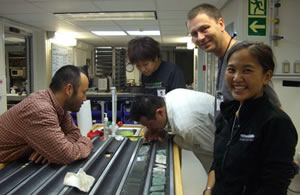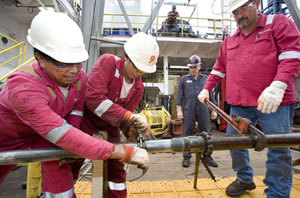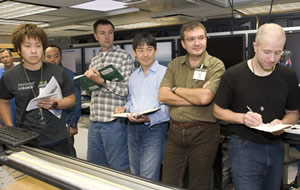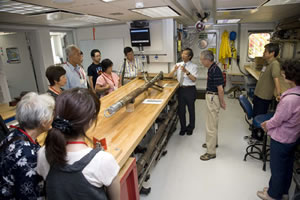IODP Expedition 324
Shatsky Rise Formation
Daily Science Report for 30 September 2009
LOCATION: Site U1347 (SRSH-3B). 32°30.476'N, 159°14.079'E (Southern High)
SCIENCE UPDATE: Core U1347A-28R and -29R (300.4 to 317.5 m CSF-A) recovered the continuation of the well-preserved, massive basalt flow already encountered in the previous core. At the base of Core U1347A-29 there is a transition to more vesicular basalt with little pieces of possibly baked sediment (detailed investigation pending) at the contact. During drilling of Core U1347A-29 the drillers noticed a further decrease in penetration rate indicating that the drill bit was worn out (after 61 hours of rotation). It was decided to terminate drilling (at 160 m penetration into basement) and to prepare the hole for logging operations. The first logging tool string (triple combo) was successfully run in the late evening, and came within 2 m of the bottom of the hole. Overall, the hole was found in good condition suitable for all logging operations that are planed for this site.
Daily Science Report for 29 September 2009
LOCATION: Site U1347 (SRSH-3B). 32°30.476'N, 159°14.079'E (Southern High)
SCIENCE UPDATE: Cores U1347A-26R and -27R (290.7 to 300.49 m CSF-A) recovered more of the well-preserved, large (pillow) basalt flows, frequently showing rounded chilled margins (containing fresh glass) and few pieces of baked sediment at the contacts between individual lobes. The excellent recovery (98%) and the good hole conditions help to compensate for the disappointingly slow penetration rate (0.7 m/hr).
Daily Science Report for 28 September 2009
LOCATION: Site U1347 (SRSH-3B). 32°30.476'N, 159°14.079'E (Southern High)
SCIENCE UPDATE: Cores U1347A-23R to -25R (262.0 to 289.2 m CSF-A) recovered
more of the well-preserved massive, basaltic flows, occasionally showing rounded (pillow lava-like) chilled (glassy) margins at the contacts between flow units. The grain size is microcrystalline to fine grained (in the inner parts of units) and the rocks are generally sparsely plagioclase-phyric, which makes this material very suitable for radiometric age dating. Section U1347A-24R-5 contains a 7 cm long piece of apparently recrystallized (baked?) sediment but detailed investigations of this piece are pending. The recovery rate continues to be exceptional (ranging from 63% to 109%) but the penetration rate is still slow (average of 1.5 m/hr).
Daily Science Report for 27 September 2009
LOCATION: Site U1347 (SRSH-3B). 32°30.476'N, 159°14.079'E (Southern High)
SCIENCE UPDATE: Coring continued (after replacing the drill bit and successfully re-entering the hole) and Cores U1347A-21R and -22R were retrieved (with 55% and 77% recovery, respectively). The lithology is similar to previous cores (well-preserved basalt flows, with occasionally chilled margins containing fresh and altered glass). Core U1347A-22R contained 35 cm of dark sediment indicating that we are still in the "layered" part of the basement as suggested based on seismic data.
Daily Science Report for 26 September 2009
LOCATION: Site U1347 (SRSH-3B). 32°30.476'N, 159°14.079'E (Southern High)
 SCIENCE UPDATE: After penetrating 85 m into igneous basement, coring in Hole U1347A was halted today to change the drill bit (after 60 hours of rotation). This allowed all lab groups to catch up with core description and sample preparation of the plentiful material recovered the last couple of days due to the excellent recovery rate. Upon closer examination, the dark black rims covering many glassy surfaces of the pillow lavas found in Cores U1347A-19R and -20R, which were reported as Mn coatings in yesterday's daily report, turned out to be baked, radiolarian-rich sediment. After the successful re-entry into Hole U1347A at 2255 hr the next core is expected to arrive late tomorrow morning.
SCIENCE UPDATE: After penetrating 85 m into igneous basement, coring in Hole U1347A was halted today to change the drill bit (after 60 hours of rotation). This allowed all lab groups to catch up with core description and sample preparation of the plentiful material recovered the last couple of days due to the excellent recovery rate. Upon closer examination, the dark black rims covering many glassy surfaces of the pillow lavas found in Cores U1347A-19R and -20R, which were reported as Mn coatings in yesterday's daily report, turned out to be baked, radiolarian-rich sediment. After the successful re-entry into Hole U1347A at 2255 hr the next core is expected to arrive late tomorrow morning.
Daily Science Report for 25 September 2009
LOCATION: Site U1347 (SRSH-3B). 32°30.476'N, 159°14.079'E (Southern High)
SCIENCE UPDATE: The recovered 7.07 m of igneous rocks in Core U1347A-18R (214.0 to 223.6 m CSF-A, corresponding to a recovery rate of 77%) seem to be a continuation of the aphyric but coarse-grained massive flow unit described in the previous core (thick individual eruption units are typical for large igneous provinces/ oceanic plateaus). No more interbedded sediment was found. In the lower part of the core a transition to massive pillow basalt units is observed. These pillow basalts (with occasional fresh glass rims and Mn coating) make up all the recovered material in the following Cores U1347A-19R and -20R (223.6 to 242.7 m).
Daily Science Report for 24 September 2009
LOCATION: Site U1347 (SRSH-3B). 32°30.476'N, 159°14.079'E (Southern High)
SCIENCE UPDATE: Cores U1347A-13R to -17R (167.0 to 214.0 m) recovered
four different igneous units (lava flows) separated by sedimentary
intervals. Fresh glass is generally preserved along the chilled
margins of the individual flows. The rocks are aphyric but coarse
grained (rich in plagioclase) and the top of each unit is generally
highly vesicular (with nice elongated pipe vesicles here and there,
sometimes filled with pyrite). The vesicularity systematically
decreases towards the non-vesicular interior). The interbedding
sediments are dark fine sands and siltstones (originating from a
volcanic material source) that show ample evidence for soft-sediment
deformation (e.g., slumping) and are rich in radiolarian fossils.
Baked margins can be found in the sediments at the contacts with the
lava units. The average recovery rate for the five cores is 50% (with
Core U1347A-13R peaking at 86%). Despite ongoing erratic vessel
movements and relatively high swell (10 feet), the penetration rate
increased significantly (2.35 m/hr over the last 20 hours).
Daily Science Report for 23 September 2009
LOCATION: Site U1347 (SRSH-3B). 32°30.476'N, 159°14.079'E (Southern High)
SCIENCE UPDATE: Cores U1347A-5R to -10R (99.8 m to 157.4 m) recovered sandy siltstone that shows evidence for significant bioturbation. When the drillers noticed a sudden increase of formation resistance at the approximate depth of expected basement contact, it was decided to recover the core barrel to preserve more material from the sediment-basement transition. Core U1347A-11R (157.4 m
to 159.6 m) recovered only 26 cm of rock but contains the sediment-basement interface with siltstone at the top and a 8 cm long volcanic piece at the bottom of the core. This piece contains fresh glass at its rim but probably also manganese coating (detailed examination is pending) supporting the assumption that it indeed represents the basement — water column interface. The next Core U1347A-12R (159.9 m to 167.0 m) recovered 2.17 m of relatively fresh, coarse-grained basalt showing a nice gradient in vesicularity (decreasing from top to bottom). All ICP-AES samples from the previous Site U1346A cores (on the Northern High) were successfully analyzed.
Daily Science Report for 22 September 2009
LOCATION: Site U1347 (SRSH-3B). 32°30.476'N, 159°14.079'E (Southern High)
SCIENCE UPDATE: The individual lab groups presented their preliminary results to the entire science party at the Site U1346 Meeting. Consistent independent evidence (from different lab groups) for relatively shallow water deposition of the sediments in Cores U1346A-4R to -5R recovered immediately above the basement at the Northern High (Shirshov Massif) was presented and discussed. The first four cores at the current Site U1347 (on the Southern High or "TAMU Massif") were recovered throughout the day. Wash barrel U1347A-1W (0 to 71.1 m) recovered only a few pieces of pumice (which are probably unrelated to Shatsky Rise volcanism), Cores U1347A-2R and -3R (71.1 m to 90.1 m) recovered pieces of chert with Core 3R containing also a 7 cm long piece of highly silicified limestone attached to the chert (described as porcellanite). Core U1347A-4R (90.1 m to 99.8 m) recovered a 75 cm long interval of sandy siltstone, rich in radiolarians and displaying cross-bedding structures.
Daily Science Report for 21 September 2009
LOCATION: Arrived at Site U1347 (SRSH-3B). 32°30.476'N, 159°14.079'E
SCIENCE UPDATE: The last data from the previous Site U1346 samples were generated (e.g. thin section description, geochemistry, paleomagnetics). Lab groups are preparing their site report chapters and summary presentations for the upcoming Site U1346 Meeting. The first sampling party for personal (post-cruise research) samples from sedimentary rocks was held in the core lab. We arrived at the new Site U1347 in the late afternoon. This site is located on the summit of the Southern High of Shatsky Rise ("TAMU Massif") and is believed to represent the initial and main phase of volcanism. The plan is to penetrate 300 m into basement at this site. Because of the spectacular intermix of sedimentary, igneous and volcaniclastic rocks recovered at the previous site, it was decided to start coring ~75 m above expected basement (instead of ~50 m).
Daily Science Report for 20 September 2009
LOCATION: Underway to Site SRSH-3B
SCIENCE UPDATE: Igneous core describers and geochemists are finishing their investigation of the last cores recovered at Site U1346. All lab groups are working on their chapters for the site report. Logging scientists are analyzing the results of the triple-combo run, and scientists are starting to compare downhole logging data with measurements made on core samples. A pre-site meeting was held to discuss upcoming operations at the next site SRSH-3B (U1347).
Daily Science Report for 19 September 2009
 LOCATION: Left Site U1346 (SRNH-2) and heading SSW
LOCATION: Left Site U1346 (SRNH-2) and heading SSW
SCIENCE UPDATE: After termination of the logging operations at 0715
hr, the drill string was recovered and the ship prepared for
transit. We left Site U1346 at 1800 and started steaming SSW (in
the direction of Site SRSH-3B) to avoid the projected path of
approaching typhoon Choi-Wan. The towed magnetometer was deployed
to record magnetic data from the hitherto poorly known southern
flank of Shatsky Rise. Core describers continue describing the last
two cores from Hole U1346A and examining the first thin sections
produced from samples from this site. Logging scientists started
interpreting the recently acquired data. All lab groups are working
on their site report chapters. Decision of the next drill site will
be made within 24 hours depending on the path of the typhoon.
Daily Science Report for 18 September 2009
LOCATION: Site U1346 (SRNH-2), 38°00.400'N, 162°38.710'E
SCIENCE UPDATE: Cores U1346A-15R and -16R (182.2 to 191.8 m) recovered more units of aphyric, partly amygdaloidal pillow basalt (36% average recovery). The geochemists are busy picking/sorting the shipboard samples using binocular microscopes to select fresh material between the amygdales for geochemical analysis. Because of the slow penetration rate, and the successful recovery of material suitable to address most of the objectives for this site, and the approach of typhoon Choi-Wan, it was decided to end drilling and to prepare the hole for logging operations. The Triple Combo tool was successfully deployed at 2145 hr and returned good readings (including the sediment-basement transition) down to 10 m above the bottom of the hole. The hole conditions, however, were not suitable for deployment of the FMS tool. The large swell (12 ft) did provide good conditions for testing the performance of the wireline heave compensator. All lab groups have started working on their site reports.
Daily Science Report for 17 September 2009
LOCATION: Site U1346 (SRNH-2), 38°00.400'N, 162°38.710'E
SCIENCE UPDATE: RCB cores U1346A-10R to -14R (158-182 m) recovered a sequence of aphyric, partly amygdaloidal pillow basalt units in various states of alteration (including fresh parts, well suitable for geochemistry and apparently age dating as well). Recovery rate ranges from 9% to 71% but the penetration rate is still slow. Carbon composition samples (from the sedimentary units above basement) and ICP-AES samples (from the igneous units) are currently being processed in the chemistry lab. We are closely monitoring the progress of typhoon "Choi-Wan," which might influence our operational planning.
Daily Science Report for 16 September 2009
LOCATION: Site U1346 (SRNH-2), 38°00.400'N, 162°38.710'E
SCIENCE UPDATE: RCB core U1346A-6R (138.9 to 141.7 m) recovered the last sedimentary material (22 cm of limestone at the top of the core including volcaniclasts, clay and shell fragments) before apparently entering the igneous basement at this site. Cores U1346A-7R to -10R (141.7 to 163.0 m) recovered variable altered, amygdaloidal basalt in which several lithological/flow units were identified. Despite a slow penetration rate (averaging 1.3 m/hr), the recovery ranged from a respectable 34% to 63%. First shipboard sampling meeting was held at 12:00 and was attended by almost the entire science party. Requested thin section samples are currently produced and close-up photographs taken. ICP-AES standards were prepared and run during the night.
Daily Science Report for 15 September 2009
LOCATION: Site U1346 (SRNH-2), 38°00.400'N, 162°38.710'E
SCIENCE UPDATE: RCB wash barrel U1346A-1W drilled from 70-100.5 m recovered a few pieces of black chert including a 20 cm long, unfractured, solid piece (proving the significant thickness of individual chert layers within the sediments covering Shatsky Rise). RCB cores U1346A-2R to -3R (recovered from 100.5-119.5 m) contained only few pieces of black chert in the core catcher. Core U1346A-4R (119.5-129.2 m) recovered a 2.9 m long spectacular succession of highly vesicular lava intermixed with calcareous sediment (interpreted as peperite) above turbiditic sediments (partly very fine grained and highly laminated) occasionally containing shell fragments. Paleontological investigation of the clay-rich core catcher sediment is not completed yet but first results confirm a lower Cretaceous age. Core U1346A-5R recovered 1.64 m of sediment rich in volcaniclastic material. All cores were run through the whole-round multisensor tracks. Labs and core flow coming up to speed.
Daily Science Report for 14 September 2009
LOCATION: Arrived at Site U1346 (SRNH-2)
SCIENCE UPDATE: Igneous core describers finished describing all Leg 198 igneous cores available on board and uploaded their observations to the LIMS database using the new DESClogik application. Layout elaboration for the Visual Core Description (VCD) sheets (or "barrel sheets") is completed for sediment cores and is in its final state for igneous sections. The whole science party was introduced to the various applications to retrieve data from the database (WebTabular, LIMS to excel et.). Co-Chief Scientist Sager gave a presentation to ship, catering and USIO personal about the scientific background of the Shatsky Rise expedition. In the late evening, the core lab was cleared of Leg 198 cores in anticipation of the first Exp. 324 (sediment) cores arriving the next day.
Daily Science Report for 13 September 2009
LOCATION: Underway to Site U1346 (SRNH-2)
SCIENCE UPDATE: Igneous core describers continue describing available Leg 198 cores in DESClogik. All others are preparing their labs for the arrival at the first site scheduled for the following day. The sampling plan with sedimentologists and paleontologists was finalized. A Pre-site meeting was held to discuss the general operations planned for Site SRNH-2. The Co-Chief Scientists and Expedition Manager are reviewing submitted drafts for the "Methods" chapter in the Proceedings.
Daily Science Report for 12 September 2009
LOCATION: Underway to Site U1346 (SRNH-2)
 SCIENCE UPDATE: Co-chief-Scientists gave a presentation to the whole science party introducing bathymetry and seismic site survey data for each of the proposed drill sites. Rational for selection of respective primary sites was discussed. Lab group work continued. Igneous core describing groups used Leg 198 cores (igneous sections from Site 1213 are available on board) to practice core description with the new DESCLogik data capture application. DESCLogik template set-up is completed for all groups. Geochemists are working on developing an improved data reduction excel spreadsheet that can be easily adopted for future hard-rock cruises. In the afternoon the Japanese educator successfully broadcasted live video interviews from the ship to the National Museum of Nature and Science in Tokyo, which were screened before an audience of more than 30 museum visitors. Shifts schedule for all scientists started at midnight.
SCIENCE UPDATE: Co-chief-Scientists gave a presentation to the whole science party introducing bathymetry and seismic site survey data for each of the proposed drill sites. Rational for selection of respective primary sites was discussed. Lab group work continued. Igneous core describing groups used Leg 198 cores (igneous sections from Site 1213 are available on board) to practice core description with the new DESCLogik data capture application. DESCLogik template set-up is completed for all groups. Geochemists are working on developing an improved data reduction excel spreadsheet that can be easily adopted for future hard-rock cruises. In the afternoon the Japanese educator successfully broadcasted live video interviews from the ship to the National Museum of Nature and Science in Tokyo, which were screened before an audience of more than 30 museum visitors. Shifts schedule for all scientists started at midnight.
Daily Science Report for 11 September 2009
LOCATION: Underway to Site U1346 (SRNH-2)
SCIENCE UPDATE: Lab group meetings continued. Each group submitted
their first draft of the methods chapter (explanatory notes) for the
Proceedings volume. Co-Chief Scientists and Expedition Manager are
busy reviewing them. Template set-up in DESCLogik (the new application
for recording descriptive data) for all four core-describing groups
(sedimentology, petrology, alteration, structure) and for
biostratigraphers is either completed or is in an advanced stage.
Operations Superintendent conducted tours to the rig floor and
introduced the drilling equipment. Logging Staff Scientists gave
presentation about logging tools and the use of logging data.
Daily Science Report for 10 September 2009
LOCATION: Underway to Site U1346 (SRNH-2)
SCIENCE UPDATE: Internet/e-mail connection was restored around 0630 and the ship continued its transit to the first drill site at the northern high of Shastky Rise ("Shirshov Massif"). Lab group meetings continued (work on templates, methods etc.). All scientists, USIO and ships personal attended live boat drill in the morning. Igneous core describers started describing Leg 198 cores (several sections from Site 1213 available on board) using their newly set up templates in the DescLogik application.
Daily Science Report for 9 September 2009
LOCATION: Underway to Site SRNH-2 and then redirected to Suno Saki Point (southern tip of Bozo peninsula)
SCIENCE UPDATE: We departed Yokohama at 0952. Lab teams composed of scientists and technical staff continue learning labs, instruments, and documenting the methods they want to apply. Lab groups also developed sampling requirements for shipboard analyses. The science party and the shipboard curator met for first sampling meeting. Procedures for developing a coordinated sampling plan (for post-cruise research) were hammered out. Satellite signal reception was restored after leaving the port of Yokohama. However, the RigNet system lost contact with the satellite again after about an hour. All attempts to fix this problem failed and at 2000 a decision was made to change course and pick up the RigNet contractor 3 nautical miles off Suno Saki point (southern tip of Boso peninsula) at 0600 in the morning (arriving by boat).
Daily Science Report for 8 September 2009
LOCATION: Pier Daikoku T3, Yokohama, Japan
SCIENCE UPDATE: Scientists continue orientation with introduction to labs, shipboard sampling and responsibilities, work flow and shifts. All scientists started writing up the methods chapter for the expedition report. Core describers are working on templates for DESCLogik.
Daily Science Report for 7 September 2009
LOCATION: Pier Daikoku T3, Yokohama, Japan
SCIENCE UPDATE: Scientists attended presentations educating them about shipboard IT services and the new data capture concept. Subsequently, scientists split into laboratory groups to further learn details of the new data capture applications. Several smaller meetings for planning educational and operational activities were held by the expedition management team. Lack of satellite signal continues to hamper our communication with the outside world.
Daily Science Report for 6 September 2009
LOCATION: Pier Daikoku T3, Yokohama, Japan
SCIENCE UPDATE: Scientists and technical staff began shipboard orientation and planning for Expedition 324. Activities included personnel introductions, review of expedition science objectives by co-chief scientists, and a safety and introductory meeting by the captain and ship's officers (including the ship's doctor). Lab groups began orientation for lab instrumentation, methods, and safety. Lab tours were conducted for the entire science party. Several tours were conducted for members of the Japanese scientific community and US embassy personnel.
 Daily Science Report for 5 September 2009
Daily Science Report for 5 September 2009
LOCATION: Pier Daikoku T3, Yokohama, Japan
SCIENCE UPDATE: Co-chief Scientists and USIO continue crossover with off-going USIO staff. Press conference and tours for Japanese and international media were held in the morning. Tours were also conducted for Museum of Nature and Sciences visitors in the afternoon. Exp. 324 scientists moved onto the ship. Loading activities (off- and on-loading) started. Outside communication is still hampered by the loss of satellite connection the moment the ship entered port.
Daily Science Report for 4 September 2009
LOCATION: Arrived Berth Daikoku T3, Yokohama (Japan) at 11:17 am
SCIENCE UPDATE: Expedition 324 Co-Chief Scientists and USIO staff met the ship upon arrival. After clearing customs, crossover activities with offgoing USIO staff were initiated. Arriving shipments were staged on the pier. Expeditions 323 and 324 Co-Chief Scientists and some USIO staff attended welcome reception hosted by JAMSTEC/CDEX.
